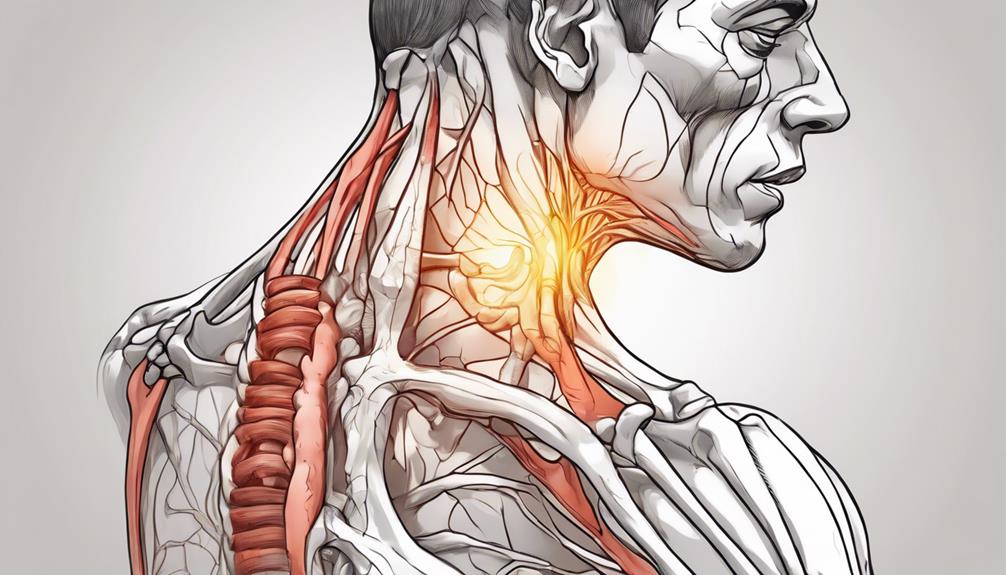Can You Get Gout in Your Shoulder
Yes, you can get gout in your shoulder. It’s caused by excessive uric acid in your blood, leading to crystal deposits in the joint. Symptoms include intense pain, swelling, redness, limited motion, and tenderness.
Diagnosing shoulder gout involves a physical exam, blood tests for uric acid levels, joint fluid analysis, and imaging tests. Treatment includes medications like NSAIDs or colchicine, dietary changes, rest, ice packs, and gentle physical therapy.
Preventive measures involve staying hydrated, eating a low-purine diet, exercising regularly, and managing other health conditions. To understand more about effective treatments and prevention strategies, explore further.
Key Takeaways
- Yes, gout can affect the shoulder joint, though it is more common in lower extremities.
- Shoulder gout is caused by excessive uric acid levels leading to crystal deposits in the joint.
- Symptoms include intense pain, swelling, redness, and limited range of motion in the shoulder.
- Diagnosis involves physical examination, blood tests for uric acid, and imaging tests like X-rays or ultrasound.
- Treatment includes medications, lifestyle changes, and physical therapy to manage pain and inflammation.
Gout Shoulder Symptoms
When gout affects the shoulder, you’ll typically experience severe pain, redness, swelling, and stiffness, which are hallmark symptoms of this condition. The sudden onset of intense pain often disrupts daily activities, making pain management a priority.
Redness and swelling are due to the inflammatory response caused by urate crystals, making the shoulder feel hot and sensitive to touch. A limited range of motion further complicates tasks, necessitating a multifaceted approach to treatment.
Effective pain management may involve a combination of medication options such as nonsteroidal anti-inflammatory drugs (NSAIDs), corticosteroids, and colchicine, which target inflammation and pain. In conjunction with medication, physical therapy can improve mobility and strengthen the shoulder, helping to restore function.
Lifestyle changes play an important role in managing and preventing shoulder gout. Adopting a diet low in purines, staying hydrated, and maintaining a healthy weight can greatly reduce uric acid levels. Regular exercise, avoiding alcohol, and reducing stress are additional preventive measures to take into account.
Consulting a healthcare provider for a detailed treatment plan is essential. A tailored approach incorporating these strategies can effectively manage symptoms and improve your quality of life.
Shoulder Gout Causes
Understanding the underlying causes of shoulder gout is essential for effective prevention and management of this painful condition. Shoulder gout arises from the accumulation of urate crystals in the shoulder joint due to elevated uric acid levels. These high uric acid levels can result from various factors, making it important to identify and address them.
To help you manage and prevent shoulder gout, consider the following:
- Dietary Choices: Consuming foods high in purines, such as red meat and seafood, can increase uric acid levels. Implementing lifestyle modifications for shoulder gout, including a balanced diet, can be beneficial.
- Hydration: Staying well-hydrated helps your kidneys eliminate uric acid more effectively. Drinking plenty of water is a simple yet effective shoulder gout prevention strategy.
- Medications: Certain medications can contribute to high uric acid levels. Consulting your healthcare provider about alternative shoulder gout management strategies can mitigate this risk.
- Alcohol Consumption: Alcohol, especially beer, can elevate uric acid levels. Limiting alcohol intake is one of the lifestyle modifications for shoulder gout that can make a significant difference.
Additionally, integrating natural remedies for shoulder gout, such as cherry extract and anti-inflammatory foods, and engaging in exercises for shoulder gout relief can further support your efforts to manage this condition effectively.
Gout Risk Factors
Identifying gout risk factors is essential for early diagnosis and effective management of shoulder gout. Recognizing these factors allows you to implement lifestyle modifications and preventive measures that can mitigate the risk. A key aspect involves dietary restrictions, such as reducing purine-rich foods, which helps lower uric acid levels.
Genetic predisposition is another critical element; if your family has a history of gout, you’re at a higher risk. Men over 40 and postmenopausal women are particularly susceptible. Obesity, alcohol consumption, and kidney dysfunction also elevate your chances of developing gout in the shoulder.
Managing comorbidities like hypertension and diabetes is important, as these conditions can exacerbate uric acid accumulation. Here’s a summary table to illustrate these factors:
| Risk Factor | Details |
|---|---|
| Dietary Restrictions | Avoid purine-rich foods (e.g., red meat, seafood) |
| Genetic Predisposition | Family history increases risk |
| Lifestyle Modifications | Reduce alcohol, maintain healthy weight |
| Comorbidities | Manage hypertension, diabetes |
| Age and Gender | Men > 40, postmenopausal women |
Addressing these risk factors through targeted lifestyle changes and medical interventions can greatly lower the risk of shoulder gout, ensuring better health outcomes for those you serve.
Shoulder Gout Diagnosis
Diagnosing shoulder gout involves a thorough approach that includes physical exams, blood tests, and advanced imaging studies like X-rays or MRIs. These diagnostic methods guarantee a complete assessment to confirm the presence of urate crystals in the shoulder joint.
- Physical Exams: Your doctor will first perform a detailed physical examination to check for signs of inflammation, swelling, and tenderness in the shoulder.
- Blood Tests: Elevated uric acid levels in your blood can strongly indicate gout. Blood tests provide critical data that support the diagnosis.
- Imaging Studies: X-rays or MRI scans are invaluable for visualizing the internal structures of the shoulder. These imaging studies can reveal joint damage or crystal deposits, differentiating gout from other conditions.
- Joint Fluid Analysis: Arthrocentesis involves extracting joint fluid from your shoulder to be examined under a microscope. The presence of urate crystals in this fluid is a definitive confirmation of gout.
Gout Vs. Pseudogout
While diagnosing shoulder gout requires a thorough approach, it’s equally important to differentiate it from pseudogout, which involves calcium pyrophosphate dihydrate crystals instead of uric acid crystals.
Both conditions can lead to crystal-induced shoulder pain, yet their distinct etiologies necessitate precise identification to avoid shoulder gout misdiagnosis.
Pseudogout shoulder presentation often mimics shoulder gout with symptoms like sudden joint pain, swelling, and stiffness. However, pseudogout typically affects older adults and is diagnosed by identifying calcium pyrophosphate crystals in joint fluid samples.
Mismanagement of gout in the shoulder could arise if pseudogout is mistaken for gout, leading to inappropriate treatment strategies.
Both conditions contribute to shoulder joint inflammation but require tailored interventions. Gout shoulder mismanagement can exacerbate symptoms, while correct identification of pseudogout ensures effective treatment, such as anti-inflammatory medications and joint aspiration.
Accurate differentiation is essential because the therapeutic approach for each differs despite overlapping clinical manifestations.
It’s essential to take into account both conditions to provide thorough care and avoid misdiagnosis. By recognizing the distinct pathological mechanisms and presentations of shoulder gout and pseudogout, healthcare providers can better serve patients, alleviating crystal-induced shoulder pain and improving overall joint function.
Gout Shoulder Treatment
Effective treatment of gout in the shoulder hinges on a combination of targeted medications, lifestyle modifications, and regular medical follow-ups to manage and alleviate symptoms. Addressing shoulder gout flare-ups promptly is important.
Here’s a detailed approach to managing this condition:
- Medications: Anti-inflammatory drugs, colchicine, and corticosteroids are the primary options for reducing inflammation and pain. Urate-lowering therapies like allopurinol can help prevent chronic shoulder gout by keeping uric acid levels in check.
- Lifestyle Modifications: Diet plays a significant role in shoulder gout prevention. Reducing intake of purine-rich foods, staying hydrated, and maintaining a healthy weight can greatly decrease the risk of flare-ups.
- Non-Medication Treatments: Applying ice packs, ensuring adequate rest, and engaging in gentle physical therapy can alleviate symptoms without pharmacological intervention. These methods can also support long-term shoulder gout prevention.
- Regular Follow-Ups: Continuous monitoring through regular medical appointments ensures early detection of potential shoulder gout complications. Blood tests and imaging studies can help adjust treatment plans as needed.
Frequently Asked Questions
Conclusion
If you’re dealing with sudden, intense shoulder pain, don’t dismiss the possibility of gout. Elevated uric acid levels can lead to urate crystals forming in your shoulder joint, causing significant discomfort.
Accurate diagnosis is essential, as gout symptoms can mimic other conditions. Effective management involves medications, lifestyle changes, and possibly surgery.
Recognizing and treating gout in your shoulder promptly can prevent future flare-ups and improve your quality of life. Always consult a healthcare professional for tailored advice.
Disclaimer: This article is intended for educational and informational purposes only. It should not be considered as professional medical advice, diagnosis, or treatment. Always consult with a qualified healthcare provider, such as a rheumatologist or physician, before making any changes to your diet or treatment plan for managing gout or any other medical condition. The information presented in this article is general and may not be suitable for all individuals. Seek personalized guidance from a medical professional to ensure appropriate care based on your specific circumstances and health status.







